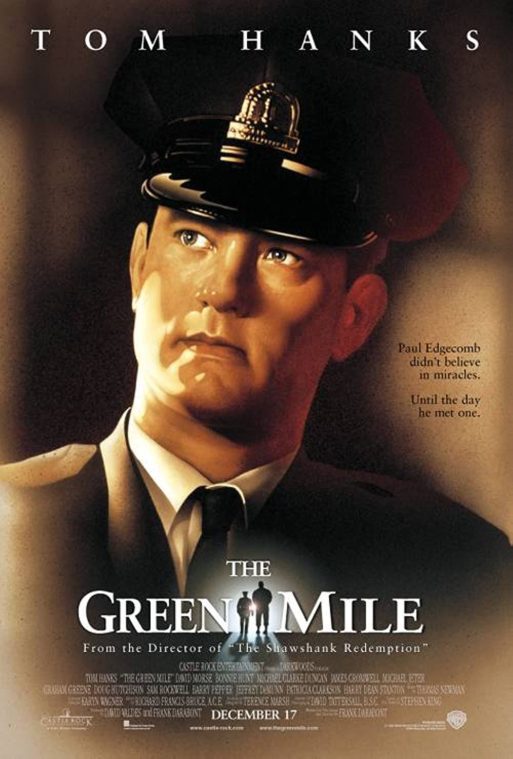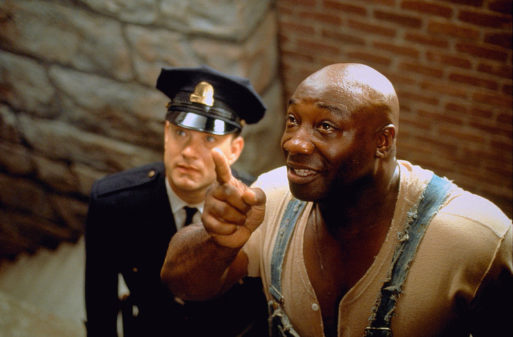 Frank Darabont’s second feature-length directorial effort, “The Green Mile” (1999), is his second film adaptation of a Stephen King novel and a look at the virtues and evils that lie in the hearts of men. Following in the wake of the critical success of Darabont’s “The Shawshank Redemption” (1994), it’s a film, once again, about the struggle between good and evil and life and death. Complete with plenty of magic and allegory, it is a great example of meticulous storytelling (maybe a little too meticulous) that effectively carries the viewer from climax to climax with plenty of great characters to love and hate along the way.
Frank Darabont’s second feature-length directorial effort, “The Green Mile” (1999), is his second film adaptation of a Stephen King novel and a look at the virtues and evils that lie in the hearts of men. Following in the wake of the critical success of Darabont’s “The Shawshank Redemption” (1994), it’s a film, once again, about the struggle between good and evil and life and death. Complete with plenty of magic and allegory, it is a great example of meticulous storytelling (maybe a little too meticulous) that effectively carries the viewer from climax to climax with plenty of great characters to love and hate along the way.
The Setting of “The Green Mile”
Set in 1935, the story centers around the lives and deaths of inmates and guards on a Louisiana death row that gets its titular nickname from the faded, green, linoleum tiles that pave the corridor leading to the execution chamber and the horrific electric chair “Old Sparky.” Tom Hanks drives the narrative with his familiar portrayal of the everyman — a good man navigating a cruel world with compassion and dignity.
He is joined in his hallmark performance by Michael Clarke Duncan, who plays a simple giant — a physically intimidating but golden-hearted black man named John Coffey who’s been falsely convicted of murder and sent to die on the Green Mile. Also joining Hanks is Sam Rockwell, who does a fantastic job portraying unhinged evil as the murderous and loathsome “Wild Bill” Wharton. And if Wharton’s not bad enough for you, Doug Hutchison will have you secretly wishing for righteous revenge with his portrayal of the sadistic and stupid Percy Wetmore, a well-connected guard who only wants to “…see one fry up close.” There are some lighter moments, as well, including one of the funniest scenes in any film ever made, thanks to our old friend Harry Dean Stanton. (Rest in peace, Harry, you’ll be missed.)

Credit: moviefone.com
Strengths and Weaknesses of “The Green Mile”
The real star here, however, is the story itself. Darabont has done such a fantastic job with the details that it’s easy to forgive him for the film’s excessive length. Yes, the one thing that’s wrong with the movie is that — at just over three hours — it lags a little between the climaxes (and probably has one too many climaxes). Still, it’s a great watch, the allegory is direct enough (it’s no coincidence that Coffey’s initials are J.C.) and its theme of life and death is universal. It is relatable, thought-provoking, and entertaining throughout. The result is a remarkably engaging piece film that works well as a companion piece to the previous work (“Shawshank Redemption”) – owing largely to Darabont’s faithful interpretation of King’s prose.
If you haven’t seen this movie yet, you’re in for a treat. If you have seen it, I recommend revisiting it (there’s plenty of fodder for multiple viewings). The many great performances offered up are a tribute to the precision of Darabont’s vision, and to the pitch-perfect casting and cinematography that make a story steeped in fantasy remarkably believable. This is a film that has — and will continue — to age well. The issues presented aren’t likely to go away anytime soon, and the quality of the picture will ensure its longevity for generations to come. It is worthy of the many accolades it has received, and worthy of your time. If you’ve no problem with a little suspension of disbelief, I think you’ll find this movie to be one you’ll revisit over the years. Enjoy the show!

 “The Green Mile” by Frank Darabont
“The Green Mile” by Frank Darabont


 Forest Bathing Eases Grief by Soaking in Nature
Forest Bathing Eases Grief by Soaking in Nature
 The Spiritual Symbolism of Cardinals
The Spiritual Symbolism of Cardinals
 Meaning-Focused Grief Therapy: Imaginal Dialogues with the Deceased
Meaning-Focused Grief Therapy: Imaginal Dialogues with the Deceased














